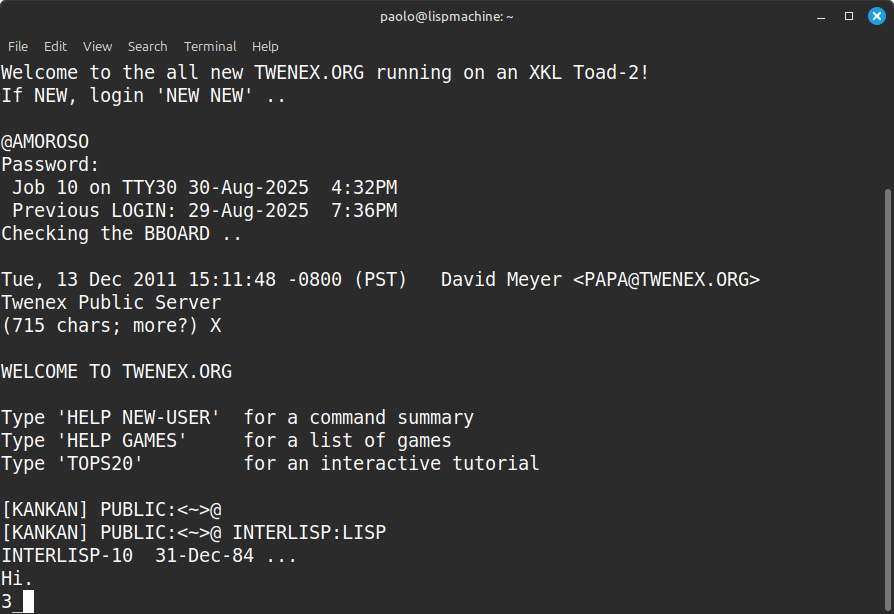I'm exploring another corner of the Interlisp ecosystem and history: the Interlisp-10 implementation for DEC PDP-10 mainframes, a 1970s character based environment that predated the graphical Interlisp-D system.
I approached this corner when I set out to learn and experiment with a tool I initially checked out only superficially, the TTY editor. This command line structure editor for Lisp code and expressions was the only one of Interlisp-10. The oldest of the Interlisp editors, it came before graphical interfaces and SEdit.
On Medley Interlisp the TTY editor is still useful for specialized tasks. For example, its extensive set of commands with macro support is effectively a little language for batch editing and list structure manipulation. Think Unix sed for s-exps. The language even provides the variable EDITMACROS (wink wink). Evaluating (PRINTDEF EDITMACROS) gives a flavor for the language.
For an experience closer to 1970s Interlisp I'm using the editor in its original environment, Interlisp-10 on TWENEX. SDF provides a publicly accessible TWENEX system running on a PDP-10 setup. With the product name TOPS-20, TWENEX was a DEC operating system for DECSYSTEM-20/PDP-10 mainframes derived from TENEX originally developed by BBN.
SDF's TWENEX system comes with Interlisp-10 and other languages. This is Interlisp-10 in a TWENEX session accessed from my Linux box:
Creating a TWENEX account is straightforward but I didn't receive the initial password via email as expected. After reporting this to the twenex-l mailing list I was soon emailed the password which I changed with the TWENEX command CHANGE DIRECTORY PASSWORD.
Interacting with TWENEX is less alien or arcane than I thought.
I recognize the influence of TENEX and TWENEX on Interlisp terminology and notation. For example, the Interlisp REPL is called Exec after the Exec command processor of the TENEX operating system. And, like TENEX, Interlisp uses angle brackets as part of directory names. It's clear the influence of these operating systems also on the design of CP/M and hence MS-DOS, for example the commands DIR and TYPE.
SDF's TWENEX system provides a complete Interlisp-10 implementation with only one notable omission: HELPSYS, the interactive facility for consulting the online documentation of Interlisp. The SDF wiki describes the basics of using Interlisp-10 and editing Lisp code with the TTY editor.
After a couple of years of experience with Medley Interlisp the Interlisp-10 environment feels familiar. Most of the same functions and commands control the development tools and facilities.
My first impression of the TTY editor is it's reasonably efficient and intuitive to edit Lisp code, at least using the basic commands. One thing that's not immediately apparent is that EDITF, the entry point for editing a function, works only with existing functions and can't create new ones. The workaround is to define a stub from the Exec like this:
(DEFINEQ (NEW.FUNCTION () T))
and then call (EDITF NEW.FUNCTION) to flesh it out.
Transferring files between TWENEX and the external world, such as my Linux box, involves two steps because the TWENEX system is not accessible outside of SDF.
First, I log into Unix on sdf.org with my SDF account and from there ftp to kankan.twenex.org (172.16.36.36) with my TWENEX account. Once the TWENEX files are on Unix I access them from Linux with scp or sftp to sdf.org. This may require the ARPA tier of SDF membership.
Everything is ready for a small Interlisp-10 programming project.
Discuss... Email | Reply @[email protected]
